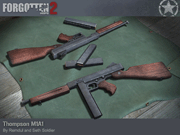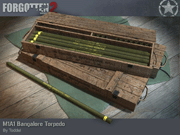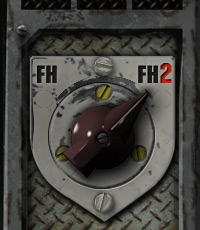 |
||
|
|
||
 |
||
|
Spring HEAT29.10.2008 21:00 GMT Hello and welcome back to another update of Forgotten Hope. Today we have some more renders of allied equipment used in Normandy. Firstly, we have the M1A1 Thompson sub-machine gun, made by Remdul and Seth Soldier. The M1A1 Thompson is quite different from the M1928 Thompson used by the British in North Africa. The newer design moved the charging handle to the side of the weapon, replaced the vertical front grip by a horizontal one, removed the muzzle brake and significantly reduced the rate of fire. These changes made the weapon much more reliable, but also cut its production costs in half. Nearly 1.4 million M1 and M1A1 Thompsons were made during World War 2. Next up is the PIAT made by Toddel. As more and more powerful tanks rolled onto the battlefield, the need arose for more powerful anti-tank weapons. Whereas the Americans developed their rocket-launcher the Bazooka and the Germans their recoilless gun the Panzerfaust, the British went in yet another direction. Their PIAT (Projector, Infantry, Anti Tank) launched a HEAT projectile using a spring. This method, unlike the Panzerfaust and Bazooka created no smoke at all, however it had some unique problems of its own. When fired the spring would push forward a heavy 5kg ballast, which would then also ignite a small charge on the projectile, pushing the ballast back and locking it into place again, so the spring would not have to be cocked after firing. This system was quite unreliable and often failed to lock the spring back in place. The operator would then have to cock the PIAT manually, which required a force of 900 Newton. The ballast also made the PIAT very heavy. It was first used in the Sicily campaign and remained the primary portable anti-tank weapon for the British throughout the war. Finally we have the Bangalore Torpedo, also by Toddel. The Bangalore Torpedo was invented in 1912 by a British Army Captain in Bangalore, India. In World War 2 the US Army adopted the Bangalore Torpedo and the allied forces used it to great success during D-day. The M1A1 Bangalore Torpedo could be deployed from behind cover. It would be build up by connecting multiple 1.5 metre sections to a length of 15 metres. A complete torpedo could clear a path of barbed wire and mines up to 15 metres long and 1 metre wide. Surprisingly, the Bangalore Torpedo is still in use with the US Army to this day. That's all for this week, but be sure to come back next time for another update. Until then, feel free to visit our IRC channel and our public forums to discuss this update and other news. |
|
||||
 |
||||||






























